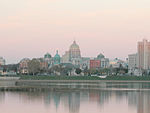Harrisburg Cemetery
1845 establishments in PennsylvaniaCemeteries in Harrisburg, PennsylvaniaCemeteries on the National Register of Historic Places in PennsylvaniaGothic Revival architecture in PennsylvaniaHistoric districts in Harrisburg, Pennsylvania ... and 6 more
Historic districts on the National Register of Historic Places in PennsylvaniaHistory of Harrisburg, PennsylvaniaNRHP infobox with nocatNational Register of Historic Places in Harrisburg, PennsylvaniaPennsylvania state historical marker significationsRural cemeteries

Harrisburg Cemetery, sometimes referred to as Mount Kalmia Cemetery, is a prominent rural cemetery and national historic district in Harrisburg, Pennsylvania, located at 13th and Liberty streets in the Allison Hill/East Harrisburg neighborhoods of the city. It was officially founded in 1845, although interments took place for many years before. The cemetery is also the burial ground for American Revolutionary War soldiers. The caretaker's cottage was built in 1850. It was designed by famed 19th Century architect, Andrew Jackson Downing, in the Gothic Revival style.It was listed on the National Register of Historic Places in 1985.
Excerpt from the Wikipedia article Harrisburg Cemetery (License: CC BY-SA 3.0, Authors, Images).Harrisburg Cemetery
Lois Alley, Harrisburg Allison Hill
Geographical coordinates (GPS) Address Nearby Places Show on map
Geographical coordinates (GPS)
| Latitude | Longitude |
|---|---|
| N 40.27203 ° | E -76.87231 ° |
Address
Lois Alley
Lois Alley
17105 Harrisburg, Allison Hill
Pennsylvania, United States
Open on Google Maps







